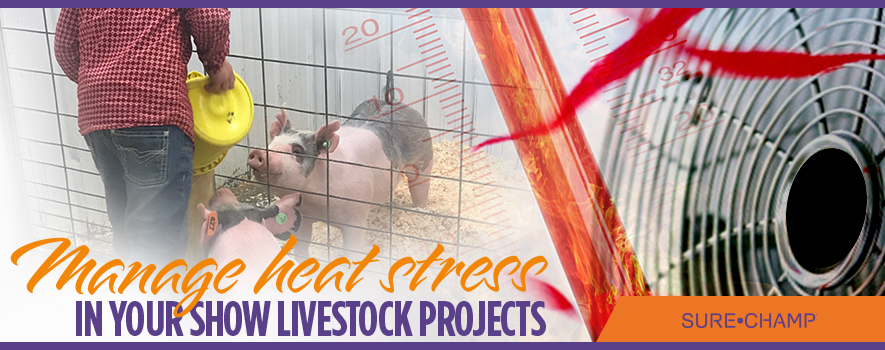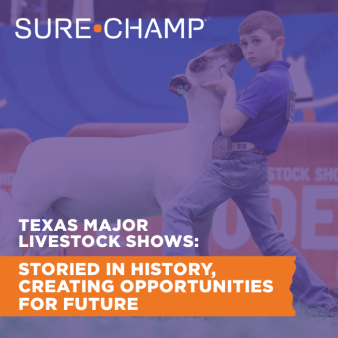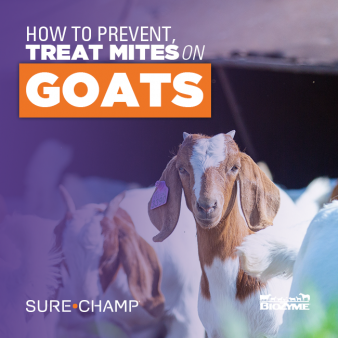
We’ve hit the hottest days of summer just as many livestock exhibitors are preparing for county and state fairs. No matter the hours of work and preparation you’ve put into your livestock projects, heat stress is a challenge to plan for and manage.
While we typically think about heat stress in extreme temperatures, the reality is that anytime the temperature exceeds 70 degrees livestock are adversely affected. Heat stress causes increased respiration rate, suppressed appetite, fatigue and dehydration, all signs of a lowered immune response. When we think about these traits and the way they affect production, it becomes very evident that the strenuous expectations we put on our show livestock to perform at the highest level and look exceptional while doing so clearly becomes a challenge.
As managers, it is imperative that we follow best practices and implement some simple, but important steps to ensure fewer setbacks due to heat stress and in turn, experience greater success with our show livestock projects.
First, take a proactive approach, and don’t just react to the temperature changes. Watch the weather, and make wise decisions. It is a lot harder to bring down livestock’s body temperature once they are hot than it is to manage it before it rises.
Next, manage your facility, and make sure it is comfortable for your animals. Be sure your animals can get out of direct sunlight into a shaded setting. Managing air flow and temperature is very important. Whether your facility at home has fans, misters, or even an elaborate cooler, controlling airflow is crucial. If you can provide an environment that minimizes exposure to the direct sunlight and allows for air to move through, even in the most extreme heat, you can drastically reduce the outside temperature. Keeping bedding wet down and misting water in the air will also help cool the air that fans push through your facility.
As the temperature rises, consider modifying your feeding program to accommodate cooler periods. Just like humans, livestock don’t want to eat when it is extremely hot. Feed earlier in the mornings so they have a chance to eat and be moved into the barn before it gets hot. Also pay attention to the location of their water supply. Smaller troughs provide more water flow and result in cooler water. Make sure lines that serve as water sources are not exposed to heat resulting in the water in the lines to get extremely hot.
Rinsing animals with cool water multiple times a day will help drop their core temperature better than anything else you do. When rinsing, focus on cooling their underline and head as it will help cool them faster. Don’t just get them wet but allow cool water to run over them a while to help drop their body temperature.
It doesn’t take long for livestock to feel the impact of heat stress when they are removed from the comforts of a temperature-controlled environment. It is essential to think about this prior to leaving for a show. For cattle that have been kept in a cooler it is very important to raise the temperature of the cooler a week to 10 days ahead, every day slowly increasing the thermostat to help them acclimate. Taking them straight from a cooler to a hot show will cause extreme stress which will ruin your opportunity for success.
BioZyme Inc., makers of Sure Champ® and Vita Charge®, have developed supplements to help your animals regulate their body temperatures, naturally. Sure Champ Extreme with Climate Control is a daily top-dress supplement that is formulated for cattle, hogs, sheep and goats and designed to help eliminate heat stress in the animals due to increased temperatures, high humidity or extreme shifts in temperatures or climate. In addition to Amaferm, a natural prebiotic that helps maximize the nutritional value of feed, it contains plant extracts that support the animal’s ability to maintain normal body temperatures. Extreme also contains garlic, to deter insects.
Vita Charge® Climate Control Gel helps all show livestock species handle heat stress by lowering the animal’s body temperature in a safe, fast and natural way. We suggest starting the gel a week to 10 days before a show and keeping livestock on the gel through the show to keep them more relaxed, cool and comfortable, resulting in better appetite and higher energy levels allowing them to look their best on show day
Strategically plan when you haul to shows. During hot periods of the year hauling at night is the most ideal to help reduce the time they will be exposed to the heat of a trailer. Make sure you have adjusted ventilation on the trailer to allow for adequate air flow while traveling.
Most importantly once you arrive to the show it’s critical to maintain the same schedule of caring for your stock. Continue to feed early and maintain body temperature by keeping animals rinsed regularly and under fans. It’s easy to get excited to see your friends and lose focus on your projects, but lots of preparation and time have been put into your animals so it’s critical to continue your same routine at the show that you have done at home. Heat stress can be a challenge at shows but can also be turned into an advantage for those who prepare properly. Stay positive, stay cool and prep to win!

